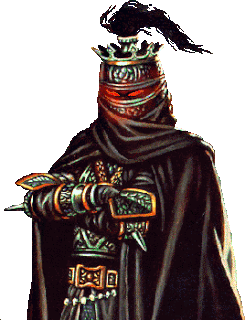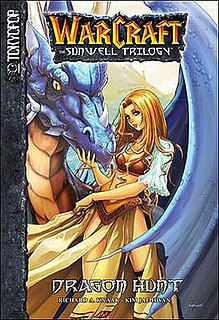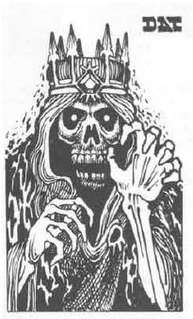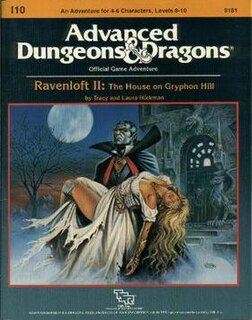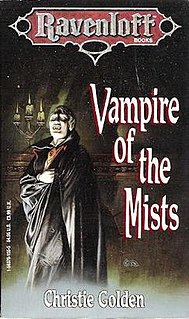History
Early life
Firan Zal'honan was born in the earldom of Knurl, a city-state in the eastern Flanaess. As the second of three sons of Lord Turalitan Zal'honan, his political future was decidedly dim from his birth, and he spent much of his childhood overlooked by his parents. From an early age, Firan demonstrated a keen intelligence, marked with a distaste for his fellow men and their deviation from discipline and order—a revulsion that manifested itself in self-loathing several times for his own perceived weaknesses. Firan respected his father's strict rulership, as well as the prior claim to succession exercised by his older brother Ranald, but disliked his father's superstitions and his bans against magic. Perhaps in a display of rebellion, Firan entered the underworld of Knurl's mages, studying under the wizard Quantarius.
As a youth, Firan seems to desire control over others and of himself above all else, although he also is given to angry outbursts and quick decisions which he later comes to regret. Even into his later lichhood and rulership status, these attributes recur, painting the portrait of a ruler demanding fealty and promising order, but secretly and constantly frustrated by the failings of his fellow men and of himself.
The only family member he loved without reservation was his younger brother, Irik. Where Firan was quick to anger and slow to forgive, Irik was the opposite. Firan pursued his studies and thirsted after knowledge, but occasionally displayed an inability or ignorance of the potential repercussions. The death of Irik would prove a telling example: At 15, Firan summoned a demon that broke loose from his power and killed Irik. Firan's actions caused his father to expel Quantarius from the city, and Firan chose to follow him into exile, continuing his studies. In time, he would learn magics that few other mages could master (and which are actually largely beyond reach of normal D&D characters): he could permanently heal himself by stealing others' life forces, he could read minds and steal magical information—completely learning new spells with a thought, he could extend his own life by draining the vitality of enemies.
Rulership of Knurl
Ranald Zal'honan died as a result of a dissipate and gluttonous lifestyle, and Firan returned to his home, assuming the seat of power and ruling as "Azal'Lan," or wizard-king. His credits include reversing the decline that Knurl suffered under Ranald's reign, and returning it to economic and military significance. Also, under his reign, magic once again became an important part of Knurl's daily life.
Firan swore allegiance to the distant Malachite Throne of the Great Kingdom, but conducted many unsanctioned military campaigns against the surrounding tribes, adding handsomely to Knurl's holdings. His reign was marked by prosperity and growth, but also by violence and dissent from the conquered tribes.
Firan was 60 when he married, as his life-extending spells started to fail and he needed an heir. His loveless marriage took 18 years to produce a son due to his wife utilizing a witch's power to prevent both her and Firan from conceiving a child. Olessa died in childbirth, cursing him. Firan named his son Irik, after his brother—but the name would carry greater resonance. His son inherited the kindness and generosity of Firan's brother, and would not follow his father's harsh footsteps, a trait Firan saw as weakness. When Irik was caught freeing political prisoners, Firan was faced with a choice: to pardon his son, or to kill him. In accordance with his own laws and as a symbol of his strict devotion to them, Firan not only permitted the execution but wielded the headsman's blade himself.
Although this act impressed upon his citizens the strictness of his rule, Firan himself was plagued with doubts over his own actions. He became obsessed alternately with finding a means to live forever, or finding a means to bring his son back from the dead to try to train him anew. As he lamented his failure as a father, a dark and nameless force presented him with the secret of lichdom.
Firan shed his mortality and changed his official title to Azal'Lan, ruling for 60 more years. During this time, Knurl became a major power in the Flanaess, even daring to renounce fealty to the Malachite Throne. Azal'Lan's military and trade power began to infringe on the territories of surrounding kingdoms, who sought ways to eliminate Azal'Lan. Assassins and armies alike seemed unable to topple him, but the course of his downfall would come from the minor tribes he had defeated early in his reign.
Azal'Lan was finally lured out of his defenses by the promise of a new magical spell that could allow a mage to restore true life to a corpse. Blinded by his hopes for restoring his son, Azal'Lan went forth with a small retinue of guards, and was then ambushed by a group of mercenaries. Fleeing their pursuit, he entered a dense fog to lose them. He was never to see Knurl again.
Arrival in Ravenloft
He appeared in Barovia, whose inhabitants called him "Azalin" upon hearing his name. Continuing in his insatiable quest for knowledge, he terrorized several local boyars searching for magical texts. During this time, he apparently discovered something similar to the life restoration spell he sought, but whether he could learn it at all is unclear (see Memory anomalies below).
It was not long before he drew the attention—and grudging respect—of the domain's dark lord. Trapped in Barovia and suffering from a strange malady that prevented him from learning new spells Azalin entered into an uneasy alliance with Strahd. Azalin, who was a more powerful spell caster than the vampire, would instruct Strahd in the magic arts in exchange for his help in Azalin's experiments which were aimed at returning the lich lord to his own plane. This collaboration led to the first concerted attempt to break through the misty border surrounding Barovia and escape using an apparatus of Azalin's design.
This attempt resulted in the pair arriving in the outworld realm of Mordent, in which lies the town of Mordentshire. There, the Apparatus split Strahd's personality into good and evil manifestations: Alchemist and Creature respectively. Azalin's role in this adventure ( The House on Gryphon Hill ) appears to be largely observational. The Alchemist and Creature's attempts to destroy each other caused the escape attempt to fail, and forced Mordent into joining the Demiplane of Ravenloft.
Memory anomalies
After the failed Mordent incident, the already-tense relation between Azalin and Strahd frayed further. When the domain of Mordent actually appeared beyond Barovia's borders, Azalin deduced that the Misty Border of Ravenloft might hold other lands, free from Strahd's authority. He entered the mists alone, and emerged in a realm of his own: Darkon.
Here, the exact nature of Azalin's existence is unclear, on two counts. The first count is the issue of a personality split—one source (King of the Dead, a canonical novel) maintains that a traveling wizard named Firan appeared at the border, while an undead lich-like creature named Darcalus materialized in Darkon's central castle, Avernus. Firan, a just and good adventurer, eventually sought out the depraved tyrant Darcalus and confronted him, rather as the Alchemist Strahd and the Creature Strahd did in Mordent. However, few other Ravenloft products refer to this (although they do not explicitly contradict it). According to King of the Dead, Firan stumbled about Darkon with no memory, and did not regain his memory until he defeated Darcalus, whereupon the undead essence merged with his own and made him Azalin once again. The novel also depicts his rage at realizing he had come so close to escaping his despicable undead state as well as the burdens of rulership.
The second count is the question of Azalin's memory. As with many Darklords, Azalin suffers a curse tailored to his personality, granted by The Dark Powers of Ravenloft. In this case, one dimension of his curse is the inability to learn any new magic at all—a crippling blow to any wizard, and downright unbearable for a lich, especially one who has knowingly sacrificed his living self so he can pursue new magics for all eternity. All sources cite this handicap, but they disagree on the time it manifested. Some sources, including King of the Dead, imply that he could not learn new magic from the moment he arrived in Barovia (such as the resurrection spell he found); others, such as the Gazetteers and campaign setting books, imply he must have been able to learn new magic while helping Strahd penetrate the Demiplane's magical secrets. The fact that he invented Bone Golems and Zombie Golems during his time with Strahd suggests that he had some ability to innovate after arriving in Ravenloft. I, Strahd: The War Against Azalin maintains that the curse struck Azalin immediately upon entering Barovia, and that the lich tutored Strahd in the arcane arts. Azalin had the vampire lord learn and cast any spells that Azalin devised but could not personally master.
What is certain is that by the time he assumed lordship of Darkon, his curse was firmly in place. Also, a similar curse strikes all travelers to Darkon, who eventually lose their memories and gain false memories of a lifetime spent in Darkon within three months' time. Azalin's domicile, Castle Avernus, houses the Book of Names—a magical tome that records these true memories as they are lost—and it is implied that Azalin himself only rediscovered his true past after reading the book.
Rulership of Darkon
After a few years spent assembling the Kargat secret police, Azalin prepared for a massive invasion of Barovia to unseat his nemesis. The invasion was thwarted by Strahd's minions, who struck at the Kargat leadership and disrupted Azalin's chain of command. Afterwards, the effort of rebuilding the Kargat, and the appearance of intervening domains such as Falkovnia, put an end to Azalin's military interest in Barovia.
Azalin's rule over Darkon was absolute: all political, military, and Kargat matters ultimately reported to him. His rule was strictly lawful to the point of ruthlessness, but based in large part on deception—both in terms of Azalin's illusion of being a mortal king, and also in the artificial docility that his civilians displayed, thanks to their false memories. However, this concentration of power had its weaknesses, especially because Azalin demonstrated several times his willingness to abandon his people and realm at a moment's notice if it means a chance of escape from Ravenloft.
Militarily, Azalin recognizes the futility of attempting to extend his borders through conquest. In defense, too, he has little to fear. On no fewer than four occasions, the neighboring country of Falkovnia to the south has declared war, and Azalin's mastery of undead has easily repulsed their soldiers.
Escape attempts
In the last 30 years, Azalin has tried to escape Ravenloft twice more.
The first attempt was in manipulating the Grand Conjunction, wherein he sent powerful heroes back in time to steal key artifacts from the formation of Ravenloft. Azalin's actions split the Demiplane open, freeing all the Darklords to terrorize other worlds. However, his hatred for Strahd proved to be his undoing: Azalin returned to face his nemesis, giving the heroes their chance to reverse the Grand Conjunction and reform the prison of Ravenloft once more. Some Darklords escaped permanently; Azalin and Strahd were not among their number.
(The actual history of the Grand Conjunction involves six tenuously-related adventures, tied together by a poetic hexad. Later source materials claimed Azalin's flaw was to disrupt the verse order of the hexad's last two couplets, although the "correct" order of the verses themselves frequently changes from product to product.)
Azalin then initiated a side project aimed at circumventing his magical curse: he magically impregnated various women with clones of himself, then tried to harvest the clones' magical knowledge when they reached adulthood after a childhood of magical tutelage. Although this experiment failed, it did result in the creation of Lowellyn Dachine, a clone (of sorts) of Azalin, and an important figure in later day Darkon.
He then toiled for 10 years in creating his "doomsday device", which would turn him into a demilich and allow his immaterial essence to escape. The prototype device turned Lowellyn Dachine into a negative planar elemental known only as Death.
The second and full application of the machine caused the Requiem, killing all life in Il Aluk, the capital city, and scattering Azalin's essence across Darkon. He remained in that state for five years before pulling himself together and taking over the corpse of his son, which had been lying in Castle Avernus for almost two hundred years. To this date, Irik's spirit haunts Azalin, reminding him constantly of his actions and urging his father towards redemption. Needless to say, Azalin gives this counsel limited heed.
During his absence, Il Aluk became an undead Necropolis, ruled by Death, and his Kargat lieutenants ran amok. Mortal agents loyal to Azalin helped to foil usurpation attempts by a rebel Kargat leader (Tavelia) and also by the new ruler of Il Aluk, Death. Although reinstalled as ruler of Darkon, Azalin's current concerns are the re-centralization of his power, the elimination of rebel Kargat officers, and the future of Necropolis, whose mere existence is a daily challenge to his own power.
Current sketch
Today, Azalin's experiments seem to focus on more than just escape. He has gained several salient powers, including the ability to look into the mind and alter the memories of anybody in Darkon. His control over undead is still absolute, with no apparent limit to the number or power of slaves thus controlled, and his spellcasting largely seen as being second to none.
Azalin's phylactery is an enormous golden dragon skull, which is almost immovably heavy. It also appears near indestructible. His dependence on it may be equal to or even less than most liches—some sources maintain that he will be instantly killed if it is destroyed, while others imply that he will survive as long as his physical body is not destroyed along with it. Like most liches, Azalin is extremely protective of his true name, although whether this is out of any true weakness (perhaps to spells such as Trap the Soul, which require the true name to be spoken) is debatable.
Azalin has commissioned the services of a scholar to travel and research the domains of Ravenloft. Speculation indicates that he is still searching for a method to escape Ravenloft. According to several products released recently, his current plan to escape Ravenloft seems to involve discovering a method to undo the magical bonds tying the Dukkar, Malocchio Aderre, to the domain of Invidia and also involve the other children of the fiendish Gentleman Caller. Since the line of the gazetteers is discontinued these will remain speculations based on hints from the Gazetteer line plot.




